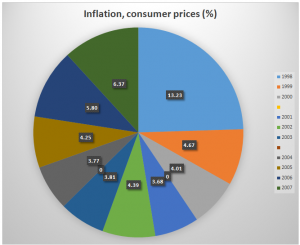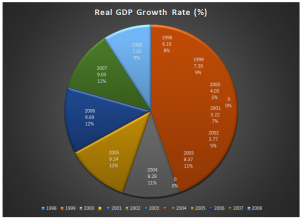Dhārāvi: Developing Asia’s Largest Slum Case Study Solution
Furthermore in order to reduce the uncertainty of fluctuation in inflation and interest rate, the historical numbers and the historical trends have been recognized. The historical trend shows decrease in the interest and inflation rate, with an increase in GDP of India. However, in 2008, the inflation rate and interest rate increased, which ultimately effected the GDP of India. In addition to this, it is also fore casted that the GDP of the India would improve, because of massive changes in the redevelopment program, which would provide an opportunity to various commercial line and industries related to the construction. When the industries start to grow, it will impact positively on the employment rate, which ultimately impacts the inflation, as a result of which inflation would be reduced.
The influence of the change in the interest rate would be minimum or negligible, because the project would be endorsed by the government department, so it would provide an opportunity to the developer or the constructor of the project to take a loan from the government bank on the favorable terms and conditions with the higher amount.
Uncertainty in increase and decrease in the real estate rate would be reduced in such a way that the rate of flats would be set in advanced, in order to reduce the future uncertainties.
Recommendations
After the analysis on issues and the prevailing problems for Dharavi Redevelopment project, it is recommended that an independent committee should be made which would responsible for the timely operation, care taking of different operation and ensuring that different activities are performed on their calculated time and the performance of the project is directly reported to the executives of the country.
The committee should be free from all types of political influences in order to ensure the efficiency productivity and execution of the project. This would also reduce the challenges that the project has the chance to face because of any kind of change in the election and change of the current government and elected party.
In addition to this, the independent committee should be consisted of creative professionals, who are currently working or haveworked in reputable organizations, in order to reduce the factor of biasness and make the decisions without any influence and entirely based on knowledge. Unbiased decisions would improve the efficiency and competency to complete the project on time without the influence of the government bodies.
Furthermore, the establishment of the independent committee would lead towards the decrease of fear of upcoming elected bodies, and help to execute and complete the project on time. Working under the independent committee would eliminate most of the pros and cons of the project and it would also get all types of support from the government bodies and departments in the execution of the project, which would lead to the successful execution of the project.
The commission should split the general project into three stages. In the first phase it should settle down all the matters with the government and establish a well-defined regulatory framework for the project. This will assist the commission to function separately, and will also identify its members ‘ span of power. The commission should deal with all the companies involved in the second stage. The commission should address all the business-related problems as well as some other household complaints. It should work together with the current local NGOs set-up to resolve these issues. In the third and final stage of the project execution, the Committee should address all the environmental issues linked to Dharavi’s residents’ companies and other operations. It should also take the assistance of NGOs in executing these stages successfully.
Conclusion
Dharavi Redevelopment Project (DRP) is a motivated plan to convert the surroundings of Dharavi into the anticipated residential and commercial territory. As it has been measured that the property prices in India are among the world’s highest property prices, which makes the scheme more profitable even after providing the free housing to all the existing residents of Dharavi, along with better facilities and an upgraded infrastructure in the same residential area.
The profit margin of the developer is 10%, which shows that it is considered to be a big profit deal for Warwick, while the return on assets on the basis of evaluation by the company is 12%, which shows that the project has an ability to generate more profits. In addition to this, the return on equity ratio is 39%, which shows that the company would generate 39% of the project upon the invested capital, which improves the earning ability of the company and is considered as an opportunity for the company to work in more redeveloping colonies of slum dwellers in the Mumbai. Furthermore, besides all the risks and uncertainties associated with the project, the project seems feasible and has an ability to generate attractive profit for the company.
The above solution would work in the long run due to unbiased committee.The trend analysis of inflation, GDP and interest rate would have little impact on the project, so it is estimated that the project would complete on time, and the redevelopment plan would improve the value of Dharavi as well as the value of Mumbai because the Dharavi exists at the prime location.
Appendices
Inflation and Consumer Prices (%)
Real GDP Growth Rate (%)
This is just a sample partical work. Please place the order on the website to get your own originally done case solution.
How We Work?
Just email us your case materials and instructions to order@thecasesolutions.com and confirm your order by making the payment here















